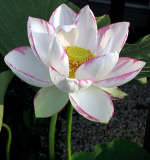| Töltsd le és telepítsd a nélkülözhetetlen betűtípusokat(s) Hogy megtekinthesd a Szanszkritot annak teljes fényében Olvass Transzliteráció (2) (magyar) hogy teljes mértékben átlásd a transzliterációs rendszert |
Tanulj Szanszkritul - Fordítás (1)
Hogyan fordíts Szanszkrit szöveget - Bevezető tanulmány
|
|
Introduction
Hi, Gabriel Pradīpaka again. On this series of documents, you will learn how to translate "real" Szanszkrit texts. Your first text will be a simple one: Śivamānasapūjā, a translation of which it is available here. I will be using that translation, but now I will explain how it was done step by step. I chose this scripture because it is easy-to-understand. As our study in translating texts goes deeper, you will face texts a little more complicated. I hope my explanation be as understandable as possible. If not, e-mail me and remove your doubts once and for all.
Śivamānasapūjā dates from 8th century A.D. approximately. It was written by Śaṅkarācārya. This renowned master taught Advaitavedānta or Non-dual Vedānta (See the series of documents in First Steps for more information). I think that the core of his teachings lies in the following simple sentence written by himself:
ब्रह्म सत्यं जगन्मिथ्या जीवो ब्रह्म इव नापरः
Brahma satyaṁ jaganmithyā jīvo brahma iva nāparaḥ
The Absolute (brahma) (is) the Truth (satyam); the world (jagat) is illusory --neither real nor unreal-- (mithyā); (and) the individual soul (jīvaḥ) (is) none (na) other (aparaḥ) than the Absolute (brahma iva)
--i.e. "jīva is not different from the Absolute"--.
Śaṅkarācārya is a celebrated master really, and his scriptures are written in exquisite and easy-to read Szanszkrit, as the above text clearly shows. That is why I have chosen one of his texts for this first study which is a preliminary approach to Szanszkrit translation.
Before starting this study, I need to come to an agreement with you regarding "abbreviations". I will have to use abbreviations in order to save space and make things easier. Study this chart and print it if you can. If you print the chart, you can have it always at hand whenever you need to know the meaning of a particular abbreviation:
| ātmn. | Ātmanepada | etym | Etymology/gically | irr. | Irregular | prep. | Preposition |
| abl. | Ablative | f. | Feminine gender | lit. | Literally | pres. | Present tense |
| above | A reference to a precedent word | fig. | Figuratively | loc. | Locative case | priv. | Privative |
| acc. | Accusative case | fr. | From | m. | Masculine gender | pron. | Pronoun |
| adj. | Adjective | fut. | Future tense | m.f.n. | Masculine, feminine and neuter | pronom. | Pronominal |
| adv. | Adverb | fut. p. p. | Future passive participle | n. | Neuter gender | redupl. | Reduplicated |
| aor. | Aorist tense | g. | Gaṇa or House | neg. | Negative | reflex. | Reflexive |
| caus. | Causal | gen. | Genitive case | nom. | Nominative case | rt. - rts. | Root - Roots |
| cf. | Compare | gr. | Grammar | opp. to | Opposed to | sc. | scilicet (viz. or videlicet; that is, namely) |
| comp. | Compound | ibc. | In the beginning of a compound | opt. | Optative mood (also known as potential mood) | sing. | Singular number |
| compar. | Comparative degree | id. | Idem | parsm. | Parasmaipada | subj. | Subjunctive |
| cond. | Conditional mood | i.e. | Id est (that is, that is to say, in other words) | p. | Page | subst. | Substantive |
| conj. | Conjunction | ifc. | In fine compositi (at the end of a compound) | part. | Participle | suff. | Suffix |
| cons. | Consonant | impers. | Impersonal | pass. | Passive voice | superl. | Superlative degree |
| dat. | Dative case | impf. | Imperfect tense | pers. | Person | vb. | Verb |
| defect. | Defective | impv. | Imperative mood | pf. | Perfect tense | ved. | Vedic or Veda |
| desid. | Desiderative | ind. | Indeclinable | pl. | Plural number | viz. | Videlicet (sc. or scilicet; that is, namely) |
| du. | Dual number | inf. | Infinitive mood | pot. | Potential mood (also known as optative mood) | voc. | Vocative case |
| e.g. | Exempli gratiâ (for example) | instr. | Instrumental case | p. p. | Past participle (do not mistake it for "present participle", which is written "present part.") | vow. | Vowel |
| esp. | Specially | intens. | Intensive | prec. | Precative | wk. | Work |
Note that even though all abbreviations are in lowercase, they might appear in uppercase sometimes. Let us begin our study now.
How to translate it: Title and 1st stanza
First of all, get a good Szanszkrit dictionary like that one of Monier-Williams (which I personally use). If you cannot do that, go to the online dictionary we recommend on the Support document. Granted, an online dictionary is not as easy and comfortable to use as an offline one, but it can serve your purpose of learning Szanszkrit... at least while you try to get a better way to find the meanings of Szanszkrit words, that is, a book or a program maybe.
Afterward, remember where to find further information (Szanszkrit section):
Writing; Transliterating; Numbers; Combination; Declension; Verbs; Compounds; Affixes and Syntax.
Let us study now how to translate the title itself and each of the stanzas:
शिवमानसपूजा
Śivamānasapūjā
It is easy to translate the title because it is a common Tatpuruṣa compound. The compounds in Szanszkrit language are generally ascendant, that is, you begin from the end and then go mostly backward.
You can search each of the words in a Szanszkrit dictionary (as that celebrated one by Monier-Williams) and you will find no problems at all in the process. So, the translation is obviously:
-Mental (mānasa) worship (pūjā) of Śiva (śiva)-
Note how I have included "of" to translate the final part of the compound. Why?, because the vast majority of the Tatpuruṣa compounds can be generally translated by inserting the preposition "of" between the members. In turn, the word "mānasa", meaning "mental", is derived from "manas" (mind), of course. The term "pūjā" is a feminine noun ending in "ā". Although the nouns ending in "ā" are usually feminine, this is not always true. For example "ātmā" (fr. "ātman") is a masculine noun despite it ends in "ā". Let us go on:
रत्नैः कल्पितमासनं हिमजलैः स्नानं च दिव्याम्बरं
नानारत्नविभूषितं मृगमदामोदाङ्कितं चन्दनम्।
जातीचम्पकबिल्वपत्ररचितं पुष्पं च धूपं तथा
दीपं देव दयानिधे पशुपते हृत्कल्पितं गृह्यताम्॥१॥
Ratnaiḥ kalpitamāsanaṁ himajalaiḥ snānaṁ ca divyāmbaraṁ
nānāratnavibhūṣitaṁ mṛgamadāmodāṅkitaṁ candanam|
Jātīcampakabilvapatraracitaṁ puṣpaṁ ca dhūpaṁ tathā
dīpaṁ deva dayānidhe paśupate hṛtkalpitaṁ gṛhyatām||1||
1) To recognize the words in the text: This is the first crucial stage in the process of translating any text in Szanszkrit. You are going to use the Rules of Sandhi which you studied in Combination. Print the document with the rules of Sandhi if you can. If so, have it always at hand. It is vital for a translator to have Sandhi Rules at his/her fingertips. That is why I taught you the Sandhi Rules before Declension, Verbs, etc. I consider Sandhi Rules to be the core of Szanszkrit grammar indeed.
When you examine the text, you will note that some words are obviously isolated, while the rest is agglutinated or forming compounds. Let us look at the first stanza now and try to identify the isolated words:
Ratnaiḥ kalpitamāsanaṁ himajalaiḥ snānaṁ ca divyāmbaraṁ
nānāratnavibhūṣitaṁ mṛgamadāmodāṅkitaṁ candanam|
Jātīcampakabilvapatraracitaṁ puṣpaṁ ca dhūpaṁ tathā
dīpaṁ deva dayānidhe paśupate hṛtkalpitaṁ gṛhyatām||1||
Well, it is rather easy no doubt. Note that if you do not know a particular word, you can always resort to the dictionary. Without a Szanszkrit dictionary (offline or online) at hand is really difficult to begin translating a Szanszkrit text except you are a fantastic scholar with a prodigious memory. Also note that I am going to identify the words according to my own capacity of memory and knowledge to make the things easier. Obviously, if you do not know any words, you will be forced to use the dictionary very often to recognize them. As time passes by, your skill will get improved and you will not have to resort to the dictionary so often as before. The following words appear to be isolated:
ratnaiḥ (how it ends in "aiḥ", it is probably the instr. pl. of "ratna" --jewel--); snānam (ablution); ca (and); candanam (sandal); puṣpam (flower); ca (and); dhūpam (--fine-- incense); tathā (as well as); dīpam (a --brilliant-- light); deva (oh God!) and gṛhyatām (it is a verb obviously --look for this term in the dictionary and you will not find it... when you cannot find a word in the dictionary, the word is likely to be a verb, a compound, etc.-- and it seems to be derived from the root "grah" --to accept, etc.--, I will see later how to translate it). The words "snānam", "puṣpam", "dhūpam" and "dīpam" appear in the text as "snānaṁ", "puṣpaṁ", "dhūpaṁ" and "dīpaṁ" by the 10th Rule of Consonant Sandhi.
Now I will try to identify agglutinate words and compounds respectively:
kalpitamāsanam (kalpitam-āsanam) - This is not a compound but an agglutination of words. To join final "m" in "kalpitam" and initial "ā" in "āsanam" together saves space when you write in Devanāgarī (original characters). Look the difference: "kalpitam āsanam" (कल्पितम् आसनम्) or else "kalpitamāsanam" (कल्पितमासनम्), that is, you substitute "mā" (मा) for "..m ā.." (...म् आ...) and save much space (and ink, hehe) in the process. "Āsanam" means "seat". This word has neuter gender (n.). Why?, because I know that the words ending in "a" form their n. by adding "m" (e.g. jalam, puṣpam, etc.). Read the Declension documents for more information. And at last, "kalpitam" (another word with n.) is of course derived from the root "kḷp"... I will explain this to you later on, do not worry. In the text, final "m" in "kalpitamāsanam" changes to "ṁ" (Anusvāra) by the 10th Rule of Consonant Sandhi.
himajalaiḥ (hima-jalaiḥ) - Just as in "ratnaiḥ", "jalaiḥ" is another instr. pl. of a word ending in "a" ("jala" --water-- in this case), and "hima" is a well-known word meaning "cold, frost, etc." (e.g. "Himālaya --Hima-ālaya--" whose literal meaning is "Frost abode", but it is poetically translated as "Abode of snow").
divyāmbaram (divya-ambaram) - The first word in this Tatpuruṣa compound (See Compounds) is "divya" (divine) and "ambaram" (garment). Although "ambaram" is in sing., I will translate it in plural number for the sake of convenience. The two words (divya + ambaram) form "divyāmbaram" by the 3rd Primary Rule of Vowel Sandhi. Besides, final "m" in "divyāmbaram" changes to "ṁ" (Anusvāra) by the 10th Rule of Consonant Sandhi.
nānāratnavibhūṣitam (nānā-ratna-vibhūṣitam) - The first word of this Tatpuruṣa compound is "nānā" (various), the second one "ratna" (gem, jewel) and the last one "vibhūṣitam" (adorned). Even though there is no "internal" Sandhi, note that the final "m" in the compound changes to "ṁ" (Anusvāra) in the text by the 10th Rule of Consonant Sandhi.
mṛgamadāmodāṅkitam (mṛgamada-āmoda-aṅkitam) - This Tatpuruṣa compound consists of three words: "mṛgamada" (musk), "āmoda" (fragrance) and "aṅkitam" (mixed). There two internal Sandhi-s (mṛgamadāmodāṅkitam) ruled by the 3rd Primary Rule of Vowel Sandhi. Moreover, the final "m" changes to "ṁ" (Anusvāra) in the text by the 10th Rule of Consonant Sandhi.
jātīcampakabilvapatraracitam (jātī-campaka-bilva-patra-racitam) - This long Tatpuruṣa is composed of five words: "jātī" (jasmine), "campaka" (campaka), "bilva" (bilva), "patra" (leaves) and "racitam" (prepared). Once again, note that the final "m" has been turned into "ṁ" (Anusvāra) in the text by the 10th Rule of Consonant Sandhi.
dayānidhe (dayā-nidhe) - This Tatpuruṣa compound is formed from two words: "dayā" (mercy) and "nidhe" (oh Ocean!).
paśupate (paśu-pate) - This Tatpuruṣa compound consists of two words: "paśu" (limited being) and "pate" (oh Lord!).
hṛtkalpitam (hṛt-kalpitam) - Another Tatpuruṣa compound. It is composed of two terms: "hṛt" (heart) and "kalpitam" (imagined). Note that final "m" in the compound appears as "ṁ" (Anusvāra) in the text by the 10th Rule of Consonant Sandhi.
2) To plot a course of translation: To make the things easier for you, I will place numbers in the transliteration and final translation to indicate the sequence you must follow in the translation of the stanza. Be warned that in those cases in which I have to place the number within a compound or an agglutination of words --e.g. kalpitam-āsanam--, I have added a hyphen after the number to indicate that it is a compound or an agglutination and not separate words. Likewise, be warned that I will also keep the words intact within a compound or an agglutination, that is, in the event of any type of Sandhi (combination), the words will appear as they "originally" are --e.g. divya-ambaram--:
Ratnaiḥ6 kalpitam4-āsanaṁ5 hima8-jalaiḥ9 snānaṁ7 ca10 divya11-ambaraṁ12
nānā13-ratna14-vibhūṣitaṁ15 mṛgamada17-āmoda18-aṅkitaṁ19 candanam16|
Jātī22-campaka23-bilva25-patra24-racitaṁ21 puṣpaṁ20 ca26 dhūpaṁ27 tathā28
dīpaṁ29 deva1 dayā2-nidhe3 paśu30-pate31 hṛt32-kalpitaṁ33 gṛhyatām34||1||
Well, before you throw the computer out the window in complete frustration, listen to my explanation: When you translate a stanza, make sure that your eyes will first go to the end part of it. Why? Because the poets "generally" place there the key words to start translating a poem. What are those key words? Nouns, epithets, verbs, etc. In this case, the first key word you find is deva (oh God!), and then an epithet: dayānidhe (oh Ocean --nidhe-- of Mercy --dayā--!) --a Tatpuruṣa compound--. The word "nidhe" is the Vocative case (See Declension) of "nidhi" (ocean, treasure, etc.). I reserved the third epithet: paśupate (oh Lord of the limited beings!) for the last part of the translation. After that, I jump back to the first line to meet the mental objects with which I want to perform the worship of Śiva in my mind. Let us study the sequence 4-6:
Ratnaiḥ6 kalpitam4-āsanaṁ5 -- The word "kalpitam" is a past participle and means "mentally formed, imagined". It is ultimately derived from the root "kḷp" (to prepare, arrange, be well ordered or regulated, etc.). "Āsanam" may means "posture" or else "seat". I chose the second translation of course, as it is the suitable one in this context. "Ratnaiḥ" means "with jewels". It is the instr. pl. of "ratna" (jewel). As you surely know (See Declension documents), the Instrumental case may be understood in the sense of "with, along with" or "by, by means of, through". I chose the first option, obviously, since "a seat by means of jewels" would have been a strange translation, wouldn't it? To form the instr. pl. of nouns ending in "a" (as "ratna"), you must substitute "aiḥ" for the final "a". For example, "aśvaiḥ" (instr. pl. of "aśva" --horse--, that is, "with the horses, by the horses, etc."). So, the literal translation of the sequence 4-6 would be the following:
With jewels mentally formed-a seat -- In other words, "a seat with jewels which has been mentally formed". I decided to add "I have" in order to give a little extra strength to the expression: (I have) mentally formed a seat with jewels. The following sequence is 7-9:
hima8-jalaiḥ9 snānaṁ7 -- The word "snānam" means "ablution". In turn, "himajalaiḥ" is formed from "hima" + "jalaiḥ". The term "hima" means "cold" while "jalaiḥ" is the instr. pl. of "jala" (water). According to my previous explanation of how to translate "ratnaiḥ" (instr. pl. of "ratna"), "jalaiḥ" might be translated as "with waters, by the waters, etc.". Obviously, I chose "with waters" in this context. Some nouns may adopt plural or singular number indistinctly. That is to say, you can say "jalena" (with water) or "jalaiḥ" (with waters) and you are saying the same thing. Of course, you will generally translate both of forms into English as simply "with water" (sing.). So, the literal translation of the sequence 7-9 would be the following:
Cold-with water an ablution -- In other terms, an ablution with cold water. Let us go on to the next sequence:
ca10 divya11-ambaraṁ12 -- The word "ca" generally means "and". This particle may be used in multiple ways: e.g. as in English, "Durgā ca sarasvatī" (Durgā and Sarasvatī --two celebrated goddesses--) or by repeating "ca" twice after the name of each of the goddesses: "Durgā ca sarasvatī ca", or else by means of only one "ca" at the end, "Durgā sarasvatī ca". These are the common ways to use "ca". Of course, no matter which one you use, the translation is always the same one: "Durgā and Sarasvatī". The compound "divyāmbaram" is a Tatpuruṣa. The word "divya" means "divine" and "ambara", garment. Though in singular number, I will translate "ambara" in pl. (i.e. garments) for the sake of convenience (it sounds any better, doesn't it?). Therefore, the complete translation of this sequence would be:
And divine garments -- Good! The next sequence is 13-15:
nānā13-ratna14-vibhūṣitaṁ15 - This is another Tatpuruṣa compound consisting of three words: "nānā" (various, multiple, etc.). The term "ratna" means "jewel, gem, etc.". I will use the translation "gem" in this case as I already have used "jewel" previously in "Ratnaiḥ kalpitamāsanam". Note that I can use in this type of Tatpuruṣa compound either numbers (singular or plural). Finally, "vibhūṣitam" is the p. p. of "vibhūṣ" (to adorn, decorate, etc.), that is to say, it means "adorned, decorated". Also note that the final "m" in the compound changes to "ṁ" (Anusvāra) in the text by the 10th Rule of Consonant Sandhi. The literal translation is:
Various-gems-adorned -- In other words, adorned with various gems. The next sequence now:
mṛgamada17-āmoda18-aṅkitaṁ19 candanam16 - There is a word ("candanam" meaning "sandal") and a compound formed from three members: "mṛgamada" (musk), "āmoda" (fragrance) and "aṅkitam" (mixed). As a matter of fact, the last term of the compound (a p. p.) literally means "marked, stamped, etc." as it is derived from the root "aṅk" (to mark, stamp, etc.). However, here it is to be understood as "mixed" to give the phrase a clear sense. The literal translation of this sequence would be:
Musk-fragrance-mixed sandal -- That is, sandal mixed with the fragrance of musk. The next sequence is 20-25:
Jātī22-campaka23-bilva25-patra24-racitaṁ21 puṣpam20 - Here is a word (puṣpam) together with a long Tatpuruṣa compound formed from five words. Even though "puṣpam" literally means "flower", here it is to be translated as "an (arrangement of) flower(s)" for the sake of convenience in the translation. You will find that many times you need to "arrange" the translation a little in order that the reader's ears not to suffer too much. As the poets must abide by the strict Szanszkrit meter (syllabic), they often simplify the sentences a bit. Of course, those little arrangements inserted by the translator should not alter the central purport of a particular text in Szanszkrit. To translate Szanszkrit is an art indeed.
The compound consists of five members: "jātī" (jasmine), "campaka" (the yellow fragrant flower of the campaka tree), "bilva" (a celebrated tree whose unripe fruit is medicinally used, while its leaves are employed in the ceremonial of the worship of Śiva), "patra" ("leaf", but translated here as "leaves") and "racitam" ("prepared", the p. p. of the root "rac" --to prepare, make, form, etc.--). The literal translation would be as follows:
Jasmine-campaka-bilva-leaves-prepared an (arrangement of) flower(s) -- In short, an (arrangement of) flower(s) prepared with jasmine, campaka (and) leaves of bilva. Very good! Next sequence now:
ca26 dhūpaṁ27 tathā28 dīpaṁ29 paśu30-pate31 - This is a piece of cake. Listen: "ca" means "and", "dhūpam" is "(fine) incense" --I added the word "fine" to make the description any more poetical--, "tathā" is "as well as" and "dīpam" is "a (brilliant) light" --I added "brilliant" to make the description any more poetical--. There is one Tatpuruṣa compound here: "paśupate". The word "paśu" (or "paśu") is generally translated as "a limited being", while "pate" is the Vocative case of "pati" (lord). Then, "pate" means "oh lord!" Therefore, "paśupate" should be translated as "oh Lord of the limited beings!" Note that even though the words may appear in singular within a compound, I can take them as plural for the sake of convenience. That is why I said "of the limited beings" and not "of the limited being". Obviously, the former is the proper one, while the latter does not make much sense in this context. Thus, the literal translation would be the following:
And (fine) incense as well as a (brilliant) light, limited beings-oh Lord -- That is to say, and (fine) incense as well as a (brilliant) light, oh Lord of the limited beings. Good job! The last sequence now:
hṛt32-kalpitaṁ33 gṛhyatām34 -- One Tatpuruṣa-s here: "hṛtkalpitam". As I told you previously, "kalpitam" means "imagined, mentally formed". In turn, "hṛt" means "heart". When you search for this word in a Szanszkrit dictionary, you will generally find "hṛd" and not "hṛt". However, note that the form "hṛt" is used in compounds when a word beginning with "k", "kh", "t", "th", "p", "ph", "ṣ" and "s" (all of them are hard consonants as final "t" in "hṛt") (See 5th Rule of Consonant Sandhi for more information) comes after "hṛd". You may wonder why "c", "ch", "ṭ", "ṭh" and "ś" (which are also hard consonants) are not included too. Well, the answer is simple: t + c or ch = cc or cch (by 1st sub-rule of the 4th Rule of Consonant Sandhi), that is, you must use the form "hṛc" instead of "hṛt" if the word coming after "hṛt" begins with "c" or "ch". In turn, if this very word begins with "ṭ" (or even "ṭh"... but this is extremely rare indeed), you must remember that t + ṭ = ṭṭ (by the 2nd sub-rule of the 4th Rule of Consonant Sandhi). In other terms, you must use the form "hṛṭ" and not "hṛt" if the word following "hṛt" begins with "ṭ" (or even "ṭh"). Finally, the combination t + ś (followed by a Vowel, a Semivowel, a Nasal or "h") = cch --this is optional but it is commonly seen in the Szanszkrit texts-- (by the 9th Rule of Consonant Sandhi). So, you must transform any hṛt + ś into "hṛcch" (e.g. hṛt + śaya = hṛcchaya --lying or abiding in the heart--). Hopefully you have understood my simple explanation. Ah, note that "hṛt" may be optionally translated as "mind" (the seat of thought and intellectual operations).
The word "gṛhyatām" is a verb obviously (if you search for this word in the dictionary, you will not find it). It is derived from the root "grah" (to accept, seize, etc.). You may wonder why I knew that. Because the verb "grah" generally is conjugated by using "gṛh". This verb belongs to the ninth House or Gaṇa. Here you are some examples of conjugations in Present and Imperfect Tenses as well as Imperative and Potential Modes, all of them in Parasmaipada:
gṛhṇāti (he/she/it accepts, seizes, etc.) --Present Tense--; agṛhṇāt (he/she/it accepted, seized, etc. recently) --Imperfect Tense--; gṛhāṇa (accept, seize, etc.) --Imperative Mode-- and gṛhṇīyāt (he/she/it would/should accept, seize, etc.) --Potential Mode--. All these example are in Active Voice, while the present word to be translated (i.e. gṛhyatām) is a conjugation in Passive Voice (See the table titled "Voices" in Verbs (1) (English) for more information). When you conjugate a verb in Passive Voice, you must conjugate it in "Ātmanepada" [See the table titled "Sets of endings" in Verbs (1) (English) for more information] as if it were a root belonging to the 4th House or Gaṇa. As you surely studied in Verbs (2) (English), the rules to conjugate a root of the 4th House are the following:
| SPECIAL RULES FOR GAṆA 4 |
| (a) Any vowel present in the root remains unchanged [except penultimate "i", "u", "ṛ" and "ḷ" when followed by "r" or "v" plus a consonant; and a penultimate or final "ṝ". See (3) and (4) in "General rules for Gaṇa-s 1, 4, 6 and 10" in Verbs (2) (English)]. (b) The Semivowel "y" is added to the root. |
So you take the root "grah" but transformed into "gṛh", as I explained to you before, and add "y" to it to form the verbal base "gṛhy". Afterward, you have to add "a" to form the "compound base", that is, "gṛhya". If you want to conjugate this verb in the 3rd pers. sing in Present Tense, you simply add "te": "gṛhyate" (he/she/it is accepted, seized, etc.) --Note how I put a written accent on "a" in "ya". This accentuation is used in pronunciation in order that a particular verb belonging to the 4th House or Gaṇa and conjugated in Active Voice not to be mistaken for the Passive form of the same verb. Besides, the verb of the 4th House, when conjugated in Active Voice and Ātmanepada, is generally accentuated on the first vowel of the base to make sure that there will not any confusion. For example: "tuṣyate" (he/she/it is pleased --Present Tense Ātmanepada, Active Voice--) and "tuṣyate" (he/she/it has been pleased --Present Tense, Passive Voice--) --watch how the written accent makes you clearly recognize both of forms--. Obviously, the accent does not appear in the original Szanszkrit characters, just in the pronunciation. This is so because I am teaching you Classic Szanszkrit for now. In Vedic Szanszkrit, there are three accents though. Some day, I will teach Vedic Szanszkrit, do not worry, but with Classic Szanszkrit you have enough for now.
Well, to finish the job, I tell you that the termination "tām" in "gṛhyatām" belongs to the 3rd pers. sing. in Imperative Mode. In other terms: "gṛhya" (compound base) + "tām" = "gṛhyatām". If it were Active Voice, the imperative form would be: "gṛhṇātu" ("let he/she/it accept!" or "may he/she/it accept!"). However, the verb is conjugated in Passive Voice, which has more to do with the thing to be accepted and not with the person who should accept, got it? Thus, the final translation of "gṛhyatām" is: may it be accepted! (i.e. may all that I have imagined in my heart be accepted!)... I add "by You" for the sake of clarification. Now, I would like to show you the entire set of conjugations for the Imperative Mode of "grah" in Passive Voice. Since any root should be conjugated in Passive Voice as if it were one belonging to the 4th House or Gaṇa (in Ātmanepada), I am going to utilize the well-known Ātmanepada's terminations which are used when you conjugate a root of the 4th House in Imperative Mode (Active Voice). Very easy:
| grah (to accept, seize, etc.) --Imperative Mode - Passive Voice-- | |||
| Singular | Dual | Plural | |
| 1st Pers. | gṛhyai | gṛhyāvahai | gṛhyāmahai |
| may I be accepted! | may both of us be accepted! | may we be accepted! | |
| 2nd Pers. | gṛhyasva | gṛhyethām | gṛhyadhvam |
| may you be accepted! | may both of you be accepted! |
may (all of) you be accepted! |
|
| 3rd Pers. | gṛhyatām | gṛhyetām | gṛhyantām |
| may he/she/it be accepted! |
may both of them be accepted! |
may they be accepted! | |
So, the sequence 32-34 is literally translated as:
Heart-imagined may it be accepted! -- In sum, (may all that I have) imagined in (my) heart be accepted (by You)!
I join all of the sequences together and get the final translation:
Oh God (deva), Ocean (nidhe) of Mercy (dayā)!, (I have mentally) formed (kalpitam) a seat (āsanam) with jewels (ratnaiḥ), an ablution (snānam) with cold (hima) water (jalaiḥ), and (ca) divine (divya) garments (ambaram) adorned (vibhūṣitam) with various (nānā) gems (ratna); sandal (candanam) mixed --"aṅkita" literally means "marked, stamped, etc."-- (aṅkitam) with the fragrance (āmoda) of musk (mṛgamada); an (arrangement of) flower(s) (puṣpam) prepared (racitam) with jasmine (jātī), campaka (campaka) (and) leaves (patra) of bilva (bilva); and (ca) (fine) incense (dhūpam) as well as (tathā) a (brilliant) light (dīpam),oh Lord (pate) of the limited beings (paśu). (May all that I have) imagined (kalpitam) in (my) heart (hṛt) be accepted (by You) (gṛhyatām)!
Good job! As you could see, to translate Szanszkrit texts is really easy... hey, do not run away in complete despair and frustration because the worst part of this mess is still to come, haha. Just kidding... hmmm... I am not sure.
to be continued
Further Information
Ezt a dokumentumot Gabriel Pradīpaka, a website egyik társalapítója készítette, aki spirituális guru és aki a Szanszkrit nyelv és a Trika filozófiai rendszerben jártas.
Szanszkrit, Yoga és indiai filozófiával kapcsolatosan, vagy ha csupán hozzászólni, kérdezni szeretnél, esetleg hibára felhívni a figyelmet, bátran lépj kapcsolatba velünk: Ez az e-mail címünk.





























